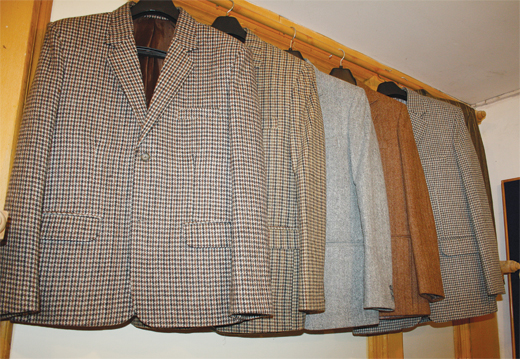Tweeds from Scotland to Srinagar do not have much difference in quality, comfort and the manufacturing process. But the Harris Tweed sells ten times the cost of Poshsih, the branded Kashmir Tweed, because it is branded, packaged, protected and sold better, argues Tasavur Mushtaq.

Kashmir’s battle against a harsh winter has made it a continuous explorer of possibilities to find warmth. Tweed is one of the products that, off late, has evolved into a fashion statement.
Tweed is a virgin wool product that envisages at least eight steps from shearing the wool to finishing the final product and all the processes are manual. Tailored into long winter coats, blazers, jackets, suits, waistcoats, trousers, shooting jackets, caps and even wedding suits, tweed provides good insulation during colder days. However, in Kashmir, it can also be tailored into a traditional Pheran, the long loose gown that people use during winters.
Kashmir Tweed is 100 per cent wool unlike the one produced in the rest of India where it has also viscose in it. Manual weaving makes it a much stronger fabric and fine, unlike the mechanical weaving. Available in a variety of textures, such as checkered, herringbone, plain, striped, hopsack, matte, hondse tooth, it costs around Rs 500 a metre. It also comes in different colours and can be lightweight, of 9NM (400-450 grams) or heavyweight, of 7NM (525- 550 grams), per meter.
Widely accepted as both formal and informal wear, tweed is durable, intricate in its design and lasts longer than other fabrics.
Tweed cloth is available across the globe. In Kashmir, it has been in the market for centuries. Initially produced in parts of south Kashmir, mostly in the Pulwama district, a number of areas in Kashmir periphery adopted this art to manage the requirements of the state-run Handloom Development Corporation that owns the impressive Poshish brand. Now it is being produced in parts of north and central Kashmir like Bandipore and Budgam as well.
As the newer generations left for white colour jobs, the number of artisans toiling hard to create the fabric almost halved. Though the Poshish brand products are always in high demand and short supply, it did not help in the appreciation of the prices over the years.
Now efforts are underway to get some major textile brands to help manage the forward linkages to market the product. In fact, global fabric giant Reid & Taylor did start working with the Handloom Corporation on Poshish and made some purchases for a couple of years. Poshish managers said the good start is expected to pave way for better sales as the tie-ups are helping them to understand the markets better. It has evolved a new series of designs and off late is selling its products online making it the first fully-owned state company to do so.
People associated with the fabric suggest that though there is not much difference between the famous Harris Tweed and the Kashmir Tweed, the latter could not take off much because it lacked the proper branding. Harris Tweed is legally protected by law and the top-notch designers have all along remained loyal to the fabric but nothing of that sort has happed to the Kashmir product. It survived because of the local market that included some of the winter belts in northern Himalayan belt.
Industry insiders suggest the Kashmir tweed has a bright future if the policymakers manage just a fraction of the winter market across the globe. Kashmir tweed sells at a fraction of what Scottish tweed demands in the global market though there is not much of the difference in the quality of the wool and its texture. Proper branding can help create a huge market and web could prove a huge tool.













